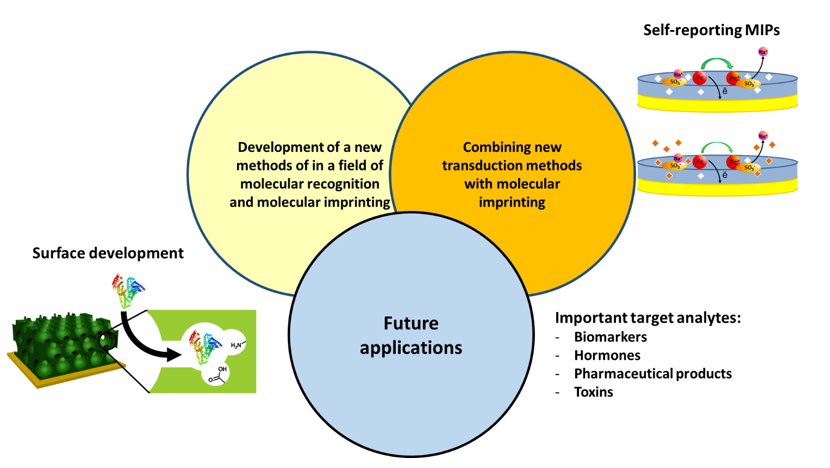Video Article Open Access
Molecularly imprinted polymers in chemosensors: Better control over deposited polymers structure for better sensors performance
Patrycja Lach, Marcin Dabrowski, Jakub Kalecki, Maciej Cieplak*, Piyush S. Sharma
Institute of Physical Chemistry, Polish Academy of Sciences, Kasprzaka 44/52, 01-224 Warsaw, Poland
Vid. Proc. Adv. Mater., Volume 2, Article ID 202111229 (2021)
DOI: 10.5185/vpoam.2021.11229
Publication Date (Web): 20 Mar 2022
Copyright © IAAM
Graphical Abstract

Abstract
Molecularly imprinted polymers (MIPs) constitute a perfect example of bioinspired functional materials. These tailor-made recognition materials that can mimic biological receptors [1]. If used as the recognition units for chemosensor fabrication, they outperform natural receptors with their durability, chemical stability, and low production costs. Novel techniques of MIP deposition as a thin film, surface development, and introduction of additional properties are very much demanded in terms of selective and sensitive chemosensors fabrication [2]. For that purpose, novel hierarchically templated polythiophene film were synthetized [3-4]. The structure of the deposited film was controlled in three size ranges. Application of 500 nm in dimeter SiO2 particles colloidal crystal as the sacrificial mold resulted in deposition of macroporous inverse opal polythiophene film. Optimized electropolymerization procedure enabled to grow polymer from the electrode surface and precisely control thickness of the deposited films. Electropolymerization was stopped in such moment that all pores were fully opened. Moreover, template protein immobilization on SiO2 colloidal crystal surface prior the electropolymerization enabled location of imprinted molecular cavities only on the pores inner surface. Semi-covalent imprinting ensured location of functional monomers solely in imprinted cavities in positions complementary to recognition sites of the template protein molecules. Such precise control over deposited MIP film structure resulted in superior analytical parameters of the devised MIP-chemosensor and, thus, it enabled target protein (i.e., HSA, hCG, or FSH) selective determination in fM concentration range. In another approach, redox-active conductive MIP film was deposited. For that purpose, ferrocene moieties were immobilized inside of the p-synephrine imprinted polythiophene film. This film acted as a self-reporting recognition material on the electrode surface. Thus, it enabled voltametric determination of electro-inactive analyte, namely p-synephrine, without addition of any redox probe to the sample solution in nM concentration range.
Keywords
Molecularly imprinted polymers; Conductive polymers; Selective chemosensors.
Acknowledgement
Author would like to acknowledge National Science Center Poland (NCN) for financial support with grant SONATA 14 no. NCN 2018/31/D/ST5/02890 and MINIATURA 1 no. NCN 2017/01/X/ST4/00471.
References
- M. Cieplak, W. Kutner, Trends Biotechnol., 2016, 34, 922
- M. Dabrowski, P. Lach, M. Cieplak,, W. Kutner, Biosens. Bioelectron., 2018, 102, 17
- M. Dąbrowski, A. Ziminska, J. Kalecki, M. Cieplak, W. Lisowski, R. Maksym, S. Shao, F. D’Souza, A. Kuhn, P. S. Sharma, ACS Appl. Mater. Interfaces, 2019, 11, 9265
- J. Kalecki, M. Cieplak, M. Dąbrowski, W. Lisowski, A. Kuhn, P. S. Sharma, ACS Sensors, 2020, 5, 118
Biography
Maciej Cieplak, after defending his PhD thesis in the Institute of Organic Chemistry PAS in Warsaw Dr. Cieplak joined Research Group of Molecular Films lead by prof. Kutner in the Institute of Physical Chemistry PAS for one-year PodDoc fellowship. After that he continued his scientific activity in IPC PAS in the same group as an adjunct. In 2018 he joined newly established Functional Polymers research group lead by prof. Sharma in IPC PAS. His scientific activity focuses on application of molecularly imprinted polymers (MIPs) for selective chemosensors fabrication. In his research dr Cieplak works mostly on improving deposition processes and enhancing properties of imprinted conductive polymers, i.e., elaboration of protein imprinted hierarchically structured MIPs deposition methodology was his most important scientific achievement. Dr. Cieplak is co author of 27 scientific papers, including two book chapters, and 6 awarded patents. In 2020 he was awarded by Ministry of Science and Higher Education with a scholarship to best young researchers in Poland.
Video Proceedings of Advanced Materials

Upcoming Congress



